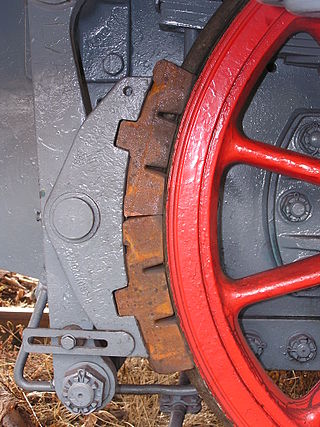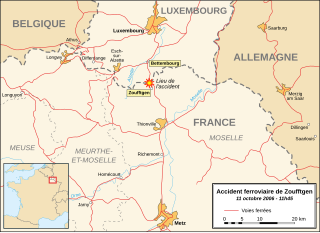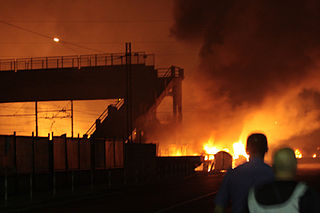
There have been four railway accidents at Potters Bar (England). Those in 1898 and 1946 were signals passed at danger. The accident in 2002 led to substantial public debate and a national change in policy relating to maintenance of infrastructure.

The Abergele rail disaster, which took place near Abergele, North Wales, in August 1868, was the worst railway disaster in Great Britain up till then.

The Hatfield rail crash was a railway accident on 17 October 2000, at Hatfield, Hertfordshire. It was caused by a metal fatigue-induced derailment, killing four people and injuring more than 70.

A railway brake is a type of brake used on the cars of railway trains to enable deceleration, control acceleration (downhill) or to keep them immobile when parked. While the basic principle is similar to that on road vehicle usage, operational features are more complex because of the need to control multiple linked carriages and to be effective on vehicles left without a prime mover. Clasp brakes are one type of brakes historically used on trains.

The Southall rail crash occurred on 19 September 1997, on the Great Western Main Line at Southall, West London. An InterCity 125 high speed passenger train (HST) failed to slow down in response to warning signals and collided with a freight train crossing its path, causing seven deaths and 139 injuries.
The 1996 Stafford rail crash occurred on 8 March 1996 when a Transrail freight train travelling from Mossend, North Lanarkshire, to Willesden, North London, derailed after an axle on a wagon carrying liquid carbon dioxide failed due to fatigue at Rickerscote 1.4 miles (2.2 km) south of Stafford on the West Coast Main Line. Almost immediately after the derailment, a Travelling Post Office mail train hauled by a Rail Express Systems British Rail Class 86 electric locomotive collided with a section of the derailed freight train on the adjacent line and fouled the path of the TPO mail train. One person, a mail sorter, was killed in the crash and twenty others including the driver of the mail train were injured.
The Purley station rail crash was a train collision that occurred just to the north of Purley railway station in the London Borough of Croydon on Saturday 4 March 1989, leaving five dead and 88 injured. The collision was caused by the driver of one of the trains passing a signal at danger; he pleaded guilty to manslaughter and was sentenced to 12 months in prison plus six months suspended, although this was reduced to four months upon appeal, and in 2007 overturned. The Department of Transport report noted that the signal had a high incidence of being passed at danger and recommended that an automatic train protection system should be introduced without delay and in the interim a repeater for the signal that had been passed be installed.
Shap Summit refers to three different route summits in close proximity, of the A6 road, M6 motorway and the highest point of the West Coast Main Line railway in England, near to the Cumbria village of Shap in North West England.

SMRT Trains Limited is a rail operator in Singapore and a wholly owned subsidiary of SMRT Corporation. After the privatisation of the MRT operations in 1995, it was originally named Singapore MRT Limited. On 31 December 2001, it was renamed to SMRT Trains Limited, so as not to confuse with another MRT line - North East MRT Line that is under Singapore Bus Services and the bus operations merged from Trans-Island Bus Services. At the same time, Singapore Bus Services was renamed to SBS Transit to be multi-modal. SMRT Trains currently manages most of the MRT services in Singapore except the North East Line and Downtown Line.

In the early evening of 8 August 1996, a Class 321 passenger train operated by Network SouthEast travelling from London Euston on the West Coast Main Line Down Slow line at around 110 km/h (68 mph) passed a signal at danger. Having applied the brakes it eventually stopped 203 m past the signal and was traversing the junction between the Down Slow line and the Up Fast line. An empty Class 321 coaching stock train approaching at roughly 80 km/h (50 mph) collided with the stationary passenger train approximately 700 m south of Watford Junction whilst progressing across the connections from the Up Slow line to the Up Fast line.
On 22 September 2006, a Transrapid magnetic levitation train collided with a maintenance vehicle near Lathen, Germany, killing 23 people. It was the first fatal accident involving a maglev train.

The 2006 Zoufftgen train collision occurred around 11.45 am on 11 October 2006, near Zoufftgen, Moselle, France, some 20 metres from the border with Luxembourg, on the Metz–Luxembourg railway line. Two trains collided head-on while one track of a double track line was out of service for maintenance. Six people, including the drivers of both trains, were killed: two Luxembourgers and four French. Twenty more were injured in the accident, two seriously.

Tebay railway station was situated on the Lancaster and Carlisle Railway (L&CR) between Lancaster and Penrith. It served the village of Tebay, Cumbria, England. The station opened in 1852, and closed on 1 July 1968.

The Viareggio derailment was the derailment and subsequent fire of a freight train carrying liquefied petroleum gas. It occurred on 29 June 2009 in a railway station in Viareggio, Lucca, a city in Central Italy's Tuscany region. Thirty-two people were killed and a further twenty-six were injured.
Thames Materials Ltd is a waste management company based in West London, UK which specialises in the removal, transfer and recycling of waste materials. The company was formed in 1995.

On 9 November 2016, a tram operated by Tramlink derailed and overturned on a sharp bend approaching a junction. Of a total 69 passengers, there were seven fatalities and 62 injured, 19 of whom sustained serious injuries. This was the first tram incident in the United Kingdom in which passengers died since 1959.

On 10 December 2016, a freight train derailed, exploded and caught fire in the village of Hitrino in Shumen Province, Bulgaria, killing at least seven people and injuring 29 others.

On 26 August 2020 a freight train carrying diesel fuel and gas oil in tank wagons derailed at Morlais Junction, Llangennech, Carmarthenshire, Wales. Some of the derailed wagons caught fire, leading to an evacuation of people living nearby. There was widespread contamination from the spilled fuel. The clean-up operation was described by Natural Resources Wales as the most challenging since the Sea Empress oil spill in 1996. The accident was caused by defective brakes on a wagon causing an axle to seize, which in turn caused deformation of the track under the train as it travelled over a set of points. The Heart of Wales Line was closed for seven months as a result of the derailment.














